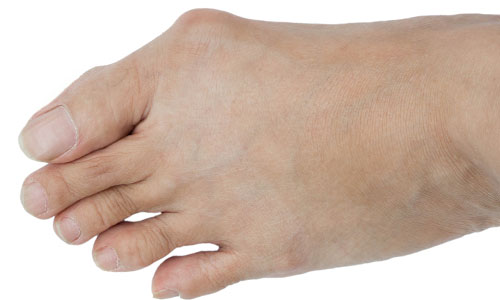Living with and getting rid of bunions
The first thing to know about bunions is what they look like. Many people think a lump on top of the foot is a bunion. However, in truth, a bunion is the swelling along the inner side of the foot at the base of the big toe. This is what it looks like…

Why do I have a bunion?
Bunions are most commonly inherited, so getting one isn’t really up to you. Usually, they are passed from mothers to daughters.
You can’t prevent bunions but you can make efforts not to aggravate them. Many people live happily with bunions that don’t cause them any pain for years. But as they become more pronounced you may experience pain and swelling as your foot begins to rub uncomfortably inside your shoe. The more the bunion grows, the more your big toe begins to point inwards towards the lesser toes.
Comfortable footwear could reduce bunion aggravation

Bunions are very rare in populations that don’t wear shoes. While there’s not enough evidence to say footwear causes bunions, it’s overwhelmingly clear that footwear is the number one contributing factor for developing a bunion. It’s extremely important to wear shoes that won’t bunch your toes together. That means avoiding high heels and shoes with a narrow toe base. Choose instead comfortable shoes that fit well but allow your toes to spread a little. If you must wear a heel, make it a low one or a wedge with a wide toe base. This is even more important if you are flat-footed, as bunions seem to progress faster in flat-footed people - use arch support and keep a close eye on your bunion’s progression.
The alternative isn’t pretty
Wearing the latest fashions might seem like the most important thing now, however a bunion can become a troublesome and painful foot deformity. As the bunion forces your big toe inwards towards the lesser toes (a condition known as hallux valgus) your big toe loses power. In a healthy foot the big toe takes up to 50% of the load, but as the structure of the foot weakens, the second toe tries to compensate. Unfortunately, it simply isn’t up to the task. The result is often a ‘hammer’ or ‘claw’ toe where one or more of the lesser toes begin to stick up in the air.
When to get your bunion looked at
The general rule is to seek advice when you start to notice problems with the rest of your foot. An x-ray will be taken to determine the severity of your bunion. For lesser bunions the use of insoles and appropriate footwear is the best course of action. There are toe spreaders or ‘bunion guards’ available, but in my experience they don’t work all that well. If it’s worse than this, you will be advised about surgery.
Treatment to get rid of bunions
A bunionectomy is not as simple as chopping the bunion off. The bony bunion is removed and the tight soft tissue pulling the bones is released. The surgeon then breaks the bones, realigns and secures them with metal (screw and/or staple) for healing.
Patients are usually on crutches for two or three days following the procedure before they are able to walk unaided with a special protective shoe. The shoe is worn for the first six weeks of recovery, after which the patient can begin wearing a normal, comfortable shoe. Swelling can continue for several months so sport or running is usually out of the question until a full recovery is made, often three to four months after the operation.
It might sound like a bit of an ordeal, but it’s nothing compared to the problems caused by bunions. If you have a small bunion, take care of your feet and you may never need surgery. If you do require surgery, be reassured that a properly performed operation has a high success rate and while the recovery period may slow you down a little, you’ll be back on your feet in no time.
Find out more about the author Mr Maneesh Bhatia at Foot and Ankle Leicester.
Interested in bunion surgery?
Fill in the form below and we'll get back to you within one working day.
Thank you
A member of the team will respond to you soon.
Last updated Wednesday 26 February 2020
First published on Thursday 9 June 2016


